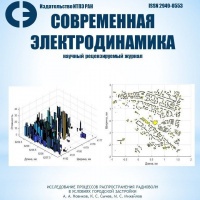
Contents
Section 1. Topics on theoretical electrodynamics
STUDY OF RADIO WAVE PROPAGATION PROCESSES IN URBAN CONDITIONS
A.A. Novikov, K.S. Sychev, M.S. Mikhailov
Abstract
The article presents the results of modeling the propagation of radio waves in urban areas using the method of step-by-step solving a parabolic equation. A program has been developed that allows, based on data on the geometry of buildings extracted from digital maps of the area, to model a selected area of the urban environment and calculate the field distribution in it at any height above the Earth’s surface (ES) and in any sections. An area within the location of the Seligerskaya metro was chosen as an experiment. The graphs show the field radiation from an antenna located on the roof of the building with the largest number of above-ground floors, and also display the shadow area.
Keywords: radio wave propagation, urban area, parabolic equation, factorization method, field distribution, digital terrain maps
Section 2. Topics on experimental electrodynamics
MEASUREMENT OF INTEGRAL EMISSION COEFFICIENTS OF MATERIALS HEATED TO TEMPERATURES FROM 100 TO 250 ºС
A.S. Ilyin, A.V. Gusev, K.A. Mailyan, A.V. Glushchenkov, A.V. Kiselev, A.V. Kachanov
Abstract
This paper studies the spatial distribution of the integral radiation coefficient (εТ) of materials heated to temperatures from 100 to 250 °C. The main attention is paid to the variation of this coefficient depending on the angle of incidence of radiation (φ). A special bench was developed for the measurements, which allows to fix εTφ with high accuracy. Polished copper surface, ground copper surface, and black ABRO and MOTIP aerosol paints were used as the investigated materials. The measurement results show that for the polished copper surface, the maximum values of εTφ are observed at angles of ±10∘, after which the coefficient smoothly decreases to a value of 0.3 at angles of ±70∘. For polished copper surface εTφ remains equal to 1 up to angles of ±40∘, then decreases to 0.47 at angles ±70∘. For ABRO and MOTIP aerosol paints, the distribution of εTφ is similar: at angles up to ±20∘ the coefficient is 1, then decreases to 0.2 (ABRO) and 0.1 (MOTIP) at angles of ±80∘.
Keywords: spatial distribution of the integral radiation coefficient of the εTφ, indicatrix, non-excluded systematic error, S.K.O., measurement error, optical radiation receiver, signal from the receiver

Editorial address: 13 b. 6, Izhorskaya st.,
This site respects your rights and maintains confidentiality when filling out, transmitting and storing your confidential information.
Placing an application on this site means your consent to the processing of data and the further transfer of your contact information to our company.
Personal data means information related to the subject of personal data, in particular the name, contact details (email address) and other data classified as personal data by Federal Law of July 27, 2006 No. 152-FZ “On Personal Data.”
The purpose of processing personal data is to inform about the services provided by our company.
